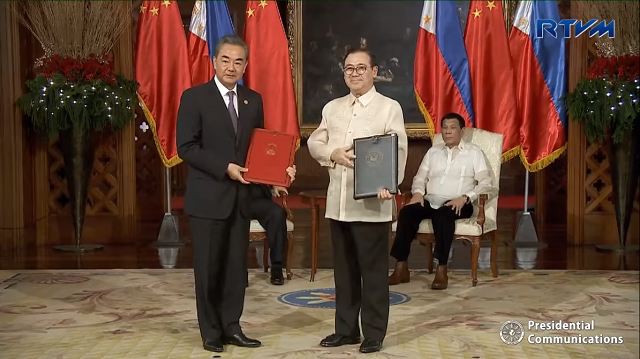Xi State Visit Aftermath: What Joint Energy Exploration?

Screengrab from RTVMalacanang’s Youtube account.
AMID TENSION over China’s continuing intrusion in the West Philippine Sea, Chinese President Xi Jinping flew to the Philippines on November 20 for a two-day state visit. It was the first by a Chinese head of state in 13 years, and during the
Malacanang earlier said the Philippine government was rushing to finish the framework agreement on the proposed joint exploration for oil and gas in the West Philippine Sea in time for Xi’s visit. The search for new energy reserves is particularly important, since the Malampaya gas field, which supplies power to Luzon, is projected to run out in less than a decade.
But no such framework was presented during and after the visit. Instead, a memorandum of understanding (MOU) on “cooperation on oil and gas development” was signed by the two countries along with 28 other deals on trade, agriculture
CMFR monitored the reporting of three broadsheets (Philippine Daily Inquirer, Philippine Star, Manila Bulletin), four primetime programs (ABS-CBN 2’s TV Patrol, GMA-7’s 24 Oras, TV5’s Aksyon and CNN Philippines’News Night), and selected online news sites from November 19 to 27.
Where is the Draft?
Documents were signed by the officials of the different ministries as appropriate with Xi and Duterte as witnesses. Media observed that copies of agreements were not immediately released.
Reporters promptly followed up on the release of the copies of the deals, with some accounts detailing the difficulty of securing these documents. Up to press time, only seven have been released to the media. Only Rappler has continued to follow up on the release of all the documents.
Inquirer, TV Patrol, News Night and Philstar.com reported on the confusion of government officials about which agency was holding the MOU on the energy cooperation, as Malacanang, the Department of Foreign Affairs (DFA) and Department of Energy (DoE) pointed to one another.
On November 22, DFA Secretary Teodoro Locsin, Jr. revealed in an interview on The Source, CNN Philippines’ public affairs program, that he wrote the agreement but had to wait for China’s permission to release the copy to the public. Locsin said the MOU was an “agreement to arrive at an agreement,” pointing out that for now, the two governments had only agreed to create an inter-governmental committee and an inter-entrepreneurial working group that will finish the cooperation agreements in 12 months.
Some print and online reports cited Locsin’s interview and DoE Secretary Alfonso Cusi saying that no joint exploration will be happening yet.
Reports, however, neither inquired about nor referred to the framework agreement that former DFA secretary Alan Peter Cayetano had supposedly been writing ahead of Xi’s visit and whether this framework was now overtaken by the MOU.
More to Discuss
Malacanang released the entire official copy of the memorandum on November 26. By this time, the media’s interest in the draft had dwindled. Other China-related controversies had caught the public’s attention, such as the influx of Chinese nationals working in the Philippines and the Chinese Coast Guard’spreventing a GMA-7 TV crew from doing interviews in Scarborough Shoal.
Online websites took the lead in releasing the complete text of the document, pointing out the important provisions of the MOU. These reports also revealed that a confidentiality clause required the two governments to agree how much information would be shared with the public.
Although Manila and Beijing are nowhere near finalizing any plans for joint energy exploration, the media cannot afford to be complacent. The difficulty of getting information at this stage warns that transparency may not be the primary interest of the two governments working together.
There are 28 other bilateral agreements that the state visit produced. With the surveys revealing the extent of public distrust of China because of its aggression in the West Philippine Sea, these are stories that need telling.
Leave a Reply